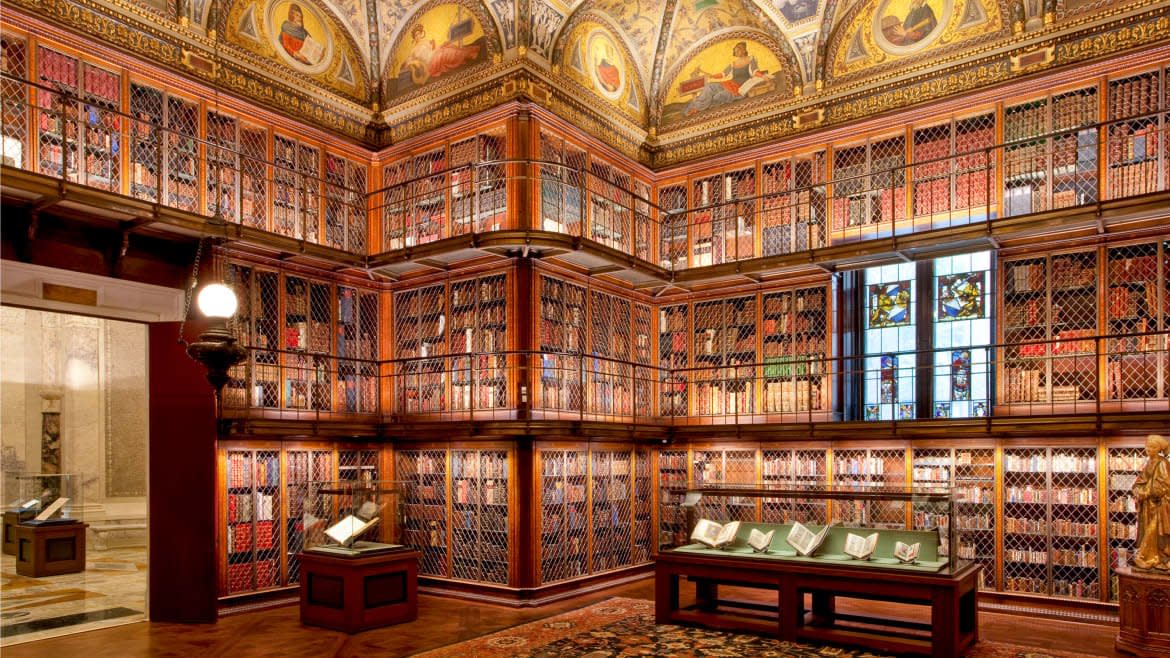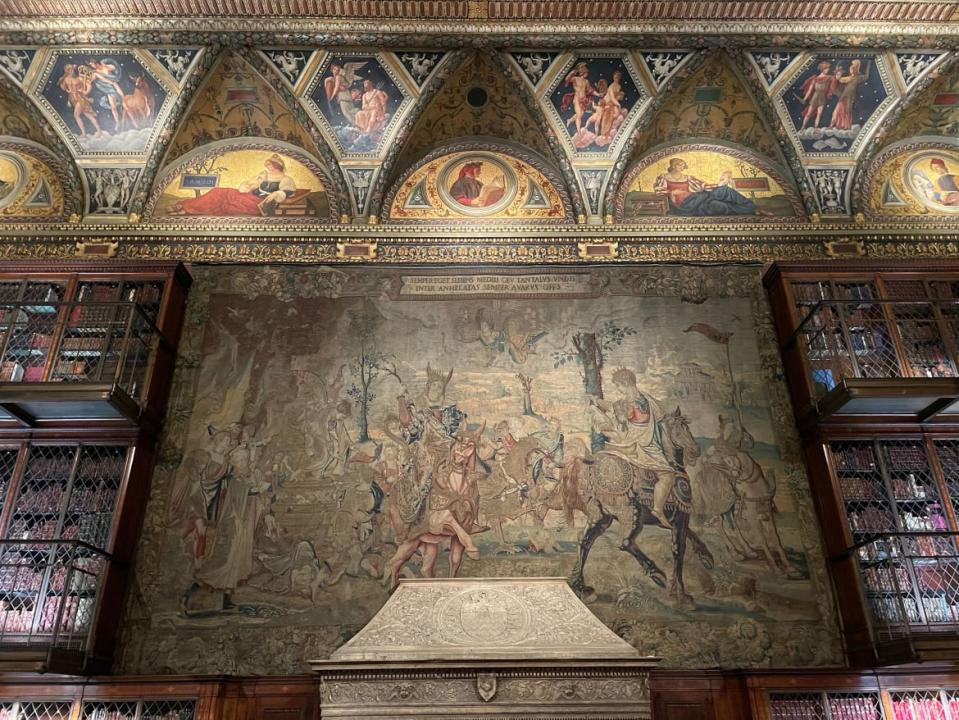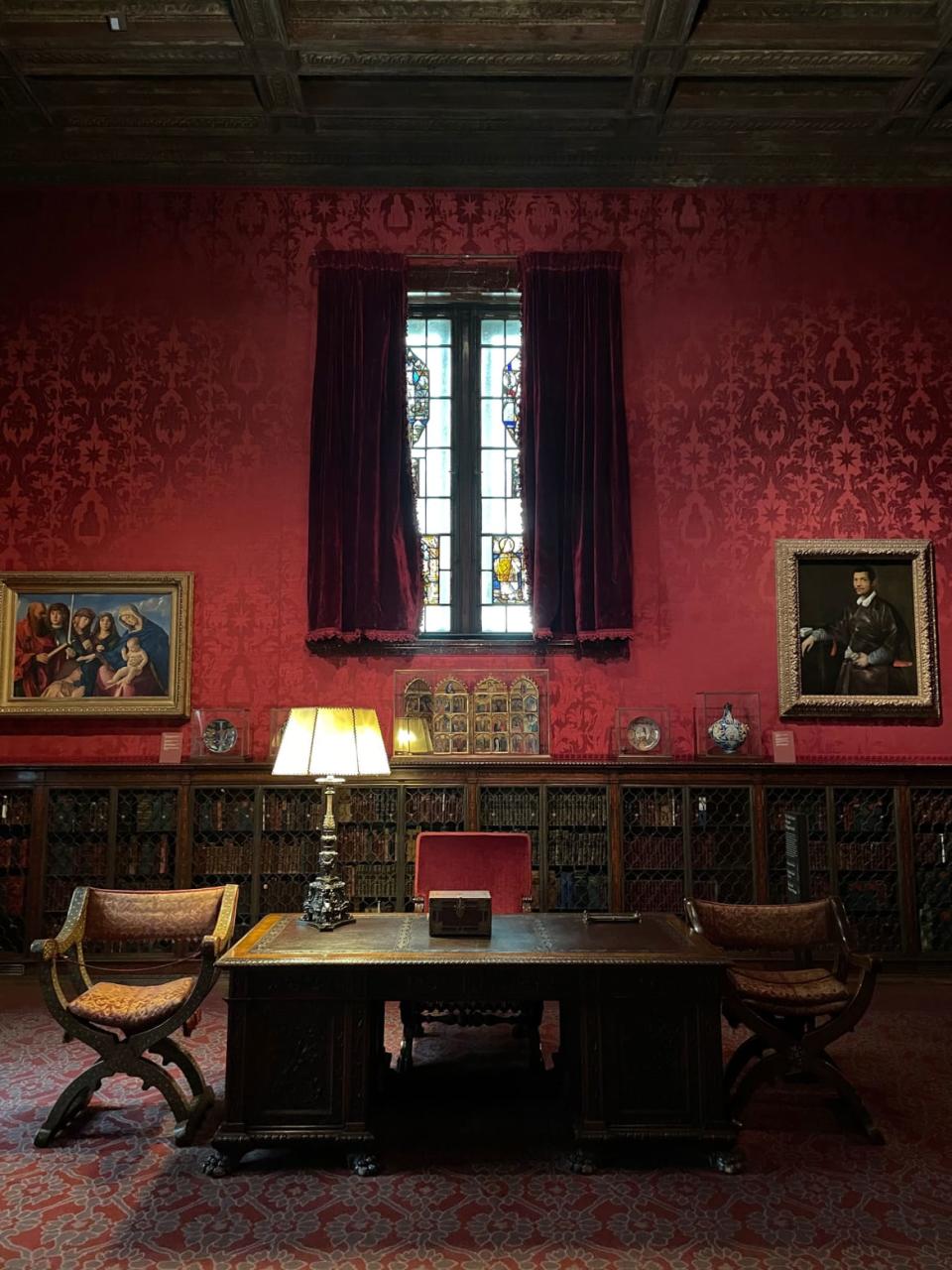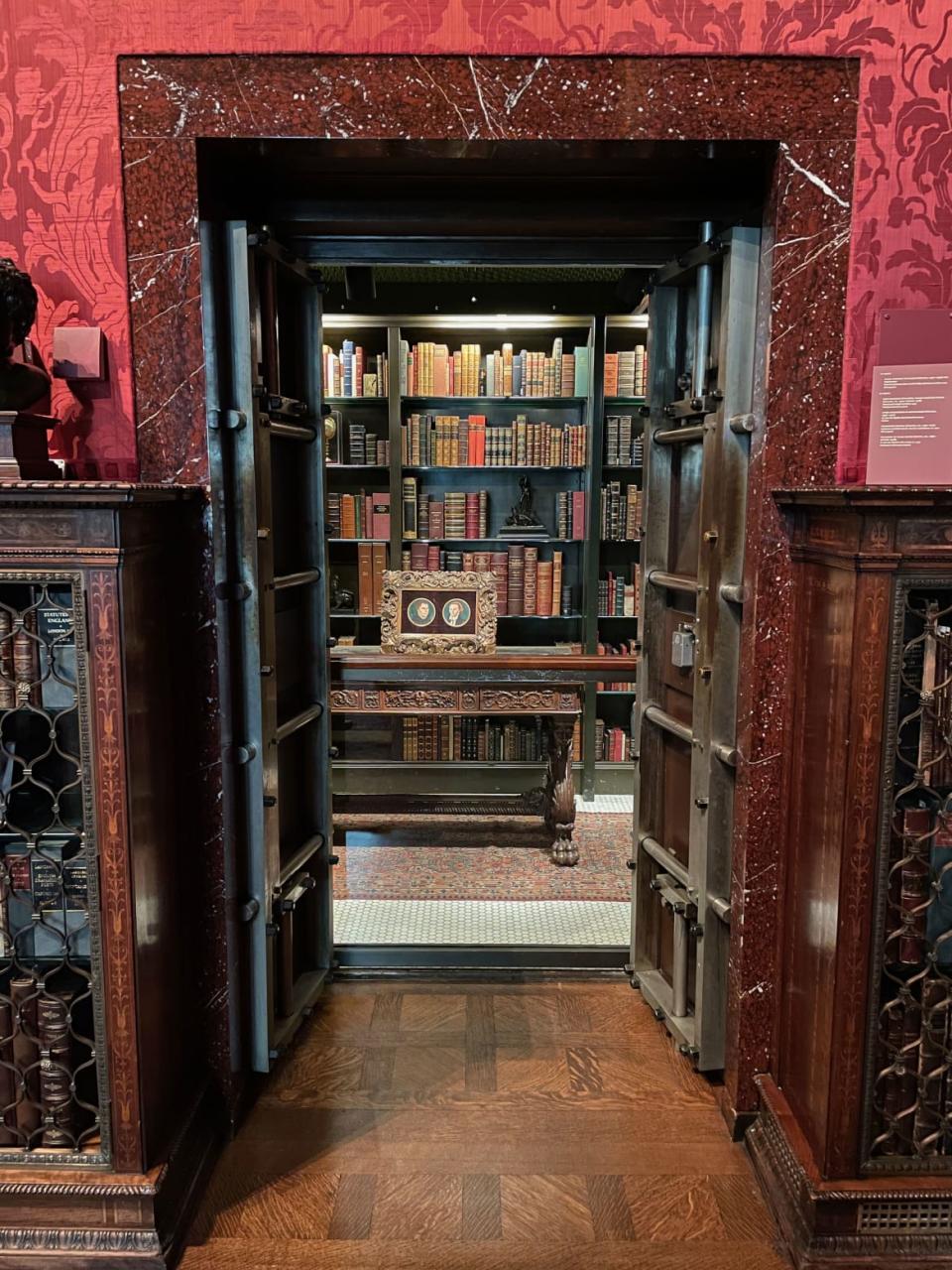NYC’s Robber Baron Library Has a Flair for the Dramatic

This is the latest in our monthly series, The World's Most Beautiful Libraries.
Walking into the library room of the Morgan Library & Museum, the eye is drawn upward. Three levels of colorfully-bound books, many priceless and irreplaceable, sit safely behind sumptuous walnut, bronze, and glass cases. The rich color scheme carries through to the ceiling, where artist Harry Siddons Mowbray depicts the various artforms alongside the twelve signs of the Zodiac. The room is dramatically dim, the only natural light pouring in from a solitary northern window. But this wasn’t the original plan. There are actually two more windows flanking the fireplace, buried behind the books.
When J. Pierpont Morgan received the keys to his library in late 1905, this room was nearing completion. A single row of bookcases sat on the floor beneath vast blank walls; Morgan’s collection of tapestries were to be hung there. But Morgan’s appetite for books was insatiable, and in 1906 he ordered more cases installed. The tapestry plan was scrapped, windows were covered over, and the new cases were painstakingly built along with their requisite catwalks. Two spiral staircases were hidden within the walls so as to not disrupt the room’s purity of design. For Morgan, perfecting this library meant having a proper showcase for his cherished collections. For his architect, it meant perhaps much more.
J. Pierpont Morgan (1837-1913) was a titan of Wall Street and founder of United States Steel, the nation’s first billion-dollar corporation. Like many wealthy men of his day, he was an avid collector of rare and expensive items. He accumulated paintings and tapestries, but his keenest interest was reserved for books and manuscripts. He scoured the globe, enlisting a team of field agents to help him find new and interesting artifacts. By 1902, it was clear that his brownstone mansion could no longer contain his holdings. He enlisted famed architect Charles F. McKim (1847-1909) of McKim Mead & White to design a proper library next to his home on 36th Street in New York’s Murray Hill district.

Charles Follen McKim, of the firm McKim Mead & White, was enlisted by Morgan in 1902 to design a library next to his home on 36th Street. That building, which forms the core of the modern Morgan Library & Museum, was one of his last works and showcases his masterful restraint. A McKim biography written in 1913 by Alfred Hoyt Granger marvels at the library’s aesthetic success: “Here was an opportunity for every form of lavish expenditure, for this was the private toy of a multimillionaire who never discussed the price when gratifying his desires. In this building restraint and discrimination are carried to the nth power. These are the two characteristics which American architecture most sadly lacks, and in a careful and exhaustive study of the Morgan library as a whole and in detail, one strengthens the belief that no great architecture can exist without them.”
The library’s exterior is made of Tennessee pink marble, constructed employing interlocking techniques such that virtually no mortar was used. Set back from the street behind an imposing gate, the entrance is flanked by stone lions sculpted by Edward Clark Potter (1857-1923), who would later produce “Patience and Fortitude,” the lions outside the New York Public Library’s main branch on Fifth Avenue. Construction on the Morgan Library was completed in 1906 after four years of intense secrecy and widespread curiosity. No members of the press or public were allowed inside, and speculation swirled as to what treasures hid within the building’s four-foot-thick walls.
While the exterior was McKim’s domain, the interior was much more of a collaboration with Morgan. Jennifer Tonkovich, the Morgan’s Eugene & Clare Thaw Curator of Drawings & Prints, spoke with me recently by phone about the library’s history and design. “Morgan did have a say, especially in the interiors, because that would be where he would be spending his time.” Lamp stands, wall finishes, fireplaces, and couches were all chosen or approved by Morgan with McKim’s blessing. “There was a lot of trust in McKim with the architectural decisions, and I think Morgan really came to play with the aesthetics of the interior.”
Morgan and McKim often sparred over interior design decisions, most notably in a bitter quarrel over a ceiling in 1905. McKim originally planned for a dome in Morgan’s study, but instead acquired a flat 16th-century wooden ceiling from his Florentine dealer. Morgan discovered the unapproved change during a site walk-through with painter Hunter S. Mowbry, who said of the episode, “the storm burst” and “we did the rest of the inspection under a thundercloud.” McKim actually left the project for some time after suffering a nervous breakdown, “in part caused by Morgan,” according to Tonkovich. “He was definitely not an easy client, is my understanding.”
Designs changed regularly along with Morgan’s moods and tastes, and the building had to keep up with his ever-expanding collection of books and documents. The main library room, much-photographed today with its three levels stacked to the ceiling with books, was initially supposed to house just one level of books with Morgan’s tapestry collection hung above. “In fact, they covered up all but one of the windows there,” Tonkovich told me. “There actually are other windows and they’re all covered over with bookshelves.”
Integral to the expansion of Morgan’s collection was his longtime librarian, Belle da Costa Greene (1883-1950). She was introduced to Morgan in 1905 while working at the Princeton Library by his nephew Junius who was a student there. Belle’s story is singularly fascinating, and will be featured in an exhibition being planned by the Morgan for its 2024 centennial celebration. Born Belle Marion Greener, she was the daughter of Richard Howard Greener, who was the first African-American person to graduate from Harvard. When he moved to Siberia, leaving his family behind in America, they changed their names and began to pass as white in society. Belle adopted the middle name “da Costa” to suggest Portuguese heritage and explain her complexion.
Belle Greene stayed on at the Morgan for nearly four decades, overseeing its transition from private collection to public institution. “She’s just so extraordinary,” Tonkovich said. Following Morgan’s death in 1913, she was kept on by his son Jack (1867-1943), who expanded the library and opened it to the public in 1928.
Greene became Morgan’s right hand in the library, coordinating purchases for him from around the globe, particularly in illuminated medieval manuscripts. One of the most extraordinary acquisitions made during Morgan’s lifetime came in 1910, when a bundle of 9th-century Coptic scripts was found in a desert well, untouched by hands or sunlight for a thousand years. “Museums like the Morgan exist to preserve these treasures,” Tonkovich said as she described the buried manuscripts to me. “And the fact that these manuscripts had survived centuries buried in a well before they were unearthed, and now they go out on view, and the public can see them, scholars can come consult them, is really extraordinary.”

Morgan was in Egypt in 1913, sailing up the Nile to Khartoum, when he fell ill and was rushed to Rome for treatment. He died there, 75 years old and one of the richest men in history. His will was vague about the fate of his library and its holdings: “He left his collections largely to his son,” Tonkovich explained, “saying to ‘make them available to the benefit of the American people,’ with no further explanation.” Thankfully for future generations of scholars, Jack Morgan fulfilled his father’s wish. Following his mother’s death in 1924, he demolished their brownstone mansion and built an annex in its place, doubling the size of the library with gallery and exhibition space. The new, expanded Morgan Library opened to the public on October 1, 1928.
The Morgan Library has continued in its mission to make its collections available to the public through decades of cultural upheaval, expansion, and war. Its collections were scattered to the countryside for safekeeping during World War II, part of a mammoth wartime effort by New York’s cultural institutions, now largely forgotten. By the 1980s, the institution had outgrown its original buildings and purchased the neighboring brownstone mansion, formerly home to Jack Morgan, in 1988. A delicate glass atrium, the work of Bart Voorsanger, joined the buildings together in 1991.
Once again in need of space and modernization, the Morgan enlisted architect Renzo Piano in 2002 to sketch out plans which would maximize its available space while preserving its landmarked original structures. Piano designed an airy glass polygon which fit into the courtyard between the McKim building, the 1928 annex, and the Jack Morgan brownstone, pushing the Morgan to the edge of its footprint. They also drilled 80 feet down into the lot’s bedrock, installing waterproof vaults for the collection’s most fragile and valuable pieces. “That was a really huge thing for us,” said Tonkovich, “in terms of professionalizing our collections storage, rather than just growing up in this warren of historic buildings.”

Today, the Morgan Library & Museum is truly more than a warren of historic buildings. It continues to make its incredible collection of books, documents, and artwork available to the public more than a century after his death. Hard work and planning by staff during the Coronavirus shutdown allowed the Morgan to safely reopen as soon as it was allowed. “Our staff really rallied,” Tonkovich told me, “and they have done an amazing job. I have been incredibly proud that we’ve been able to still welcome visitors, especially students. They’ve been able to come in and work on their projects. You know, it’s a different system but we’re still making it possible.”
Get our top stories in your inbox every day. Sign up now!
Daily Beast Membership: Beast Inside goes deeper on the stories that matter to you. Learn more.

 Yahoo Movies
Yahoo Movies 
